My Tuna Tataki (Seared Tuna) is a block of sashimi tuna lightly seared and served with Ponzu dressing. It is almost like the Tuna Tataki dish at the world-famous chef Nobu’s restaurant.
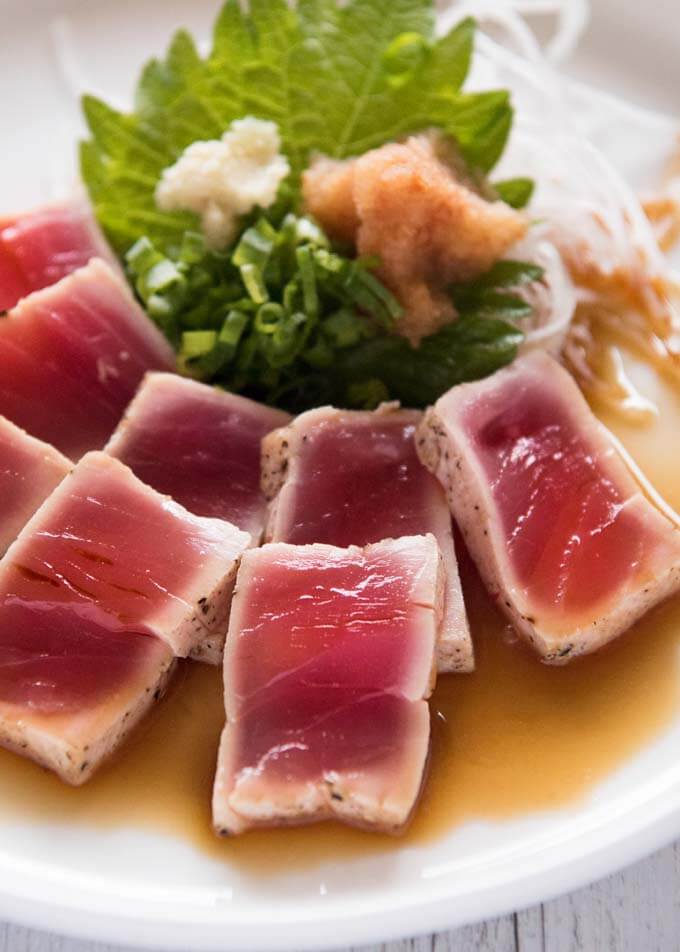
This is one of the very popular and tasty dishes often served at Japanese restaurants. You probably pay dearly for it at restaurants, but you can easily make it at home. All you need is a block of sashimi tuna and home-made Ponzu!
In my posts Japanese-style Kingfish Tartare (Kingfish Tataki) and Bonito Tataki (Seared Bonito) I talked about two Japanese cooking methods called ‘tataki’ (たたき).
In Japan, the seared tataki is most commonly made with bonito by grilling the surface of the fillet. But today’s tataki is made with a sashimi tuna block, which is easier to find (at least in Sydney) and less fiddly to sear.
How to Make Tuna Tataki
There are only 3 steps to making Tuna Tataki and it takes less than a couple of minutes to cook.

Step 1: You will need a cuboid-shaped block of sashimi tuna. It is important to have a cuboid block (or as close to it as possible) to sear the tuna evenly.
If you can only buy a chunk of sashimi tuna sliced perpendicular to the backbone (sold like a round triangular shape), see my post Sashimi (Sliced Raw Fish), which shows how to get blocks out of a big triangle piece. It’s ok to have 3-4 short cuboid pieces instead of two 10cm/4″ pieces like those in the step-by-step photo.
Step 2: Season the tuna with salt and pepper only on four long sides. Do not season on the small sides that are adjacent to the four long sides (the square sides in my step-by-step photo, because only the long sides will be seared.
Step 3: Cook seasoned sides over high heat with a bit of oil. Only cook for 15-20 seconds on each side until you get 2-3mm/1/8″ of seared trimming around the tuna block (see the step-by-step photo ).
Now your Tuna Tataki is done! Cool it down before slicing it. I slice it into about 5-6mm/¼” thick pieces.
About Ponzu Dressing
In today’s recipe, I used a home-made Ponzu dressing that I posted in Japanese Dressings.
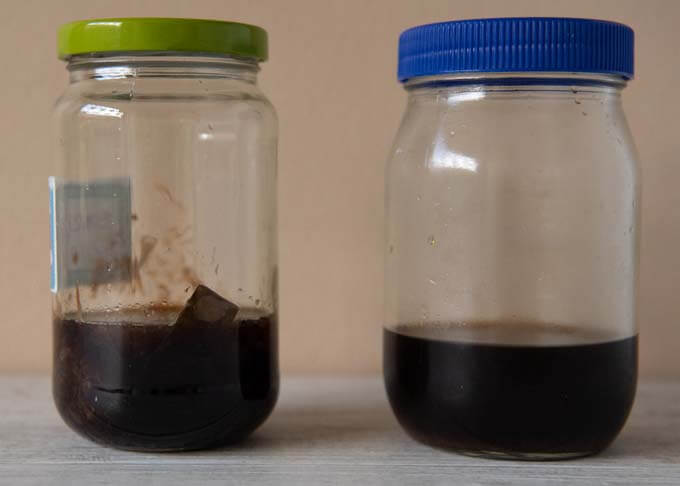
Left: Home-made Ponzu with ingredients still in the liquid. Right: After straining through a sieve.
In my Ponzu recipe, I listed lemon or lime juice. But the most popular authentic ponzu dressing is made with a Japanese citrus fruit called ‘yuzu’ (ゆずor 柚), which is tart and fragrant – close to grapefruit but not so sweet. If you can source fresh yuzu, by all means make ponzu with yuzu instead of lemon or lime juice.
I had one fresh yuzu that I bought at the Japanese grocery store. But one yuzu was not enough to make the amount of Ponzu I wanted to make so I added freshly squeezed lemon juice and a little bit of orange juice. You can try different citrus juices to make Ponzu variations.
Ponzu is a very handy dressing to have – it can keep many months in the fridge. I often use ponzu to eat with hot or cold tofu. Yum.
Serving Tuna Tataki – Option 1
I have two ways of serving Tuna Tataki today. The first option is a very simple presentation with vegetables at hand.
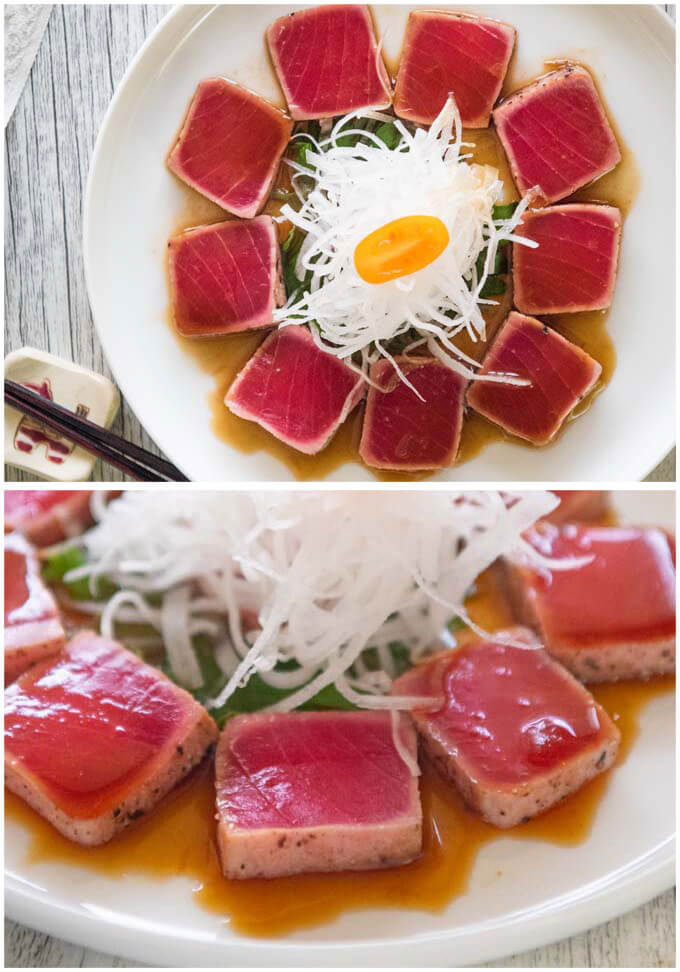
The hero of today’s dish is Tuna Tataki so I presented the tuna slices in a circle to show off. I then filled the centre with suitable vegetables I had on hand, i.e. perilla leaf and julienned daikon (white radish).
Instead of perilla leaf and daikon, you can use soft lettuce leaves. Because the colour of Tuna Tataki is deep red, I think that the light colour is better suited as a garnish.
Drizzle Ponzu over the tuna or serve Ponzu separately for each individual to pour over.
Serving Tuna Tataki – Option 2
This serving option takes a little bit more effort than Option 1 because it comes with condiments.
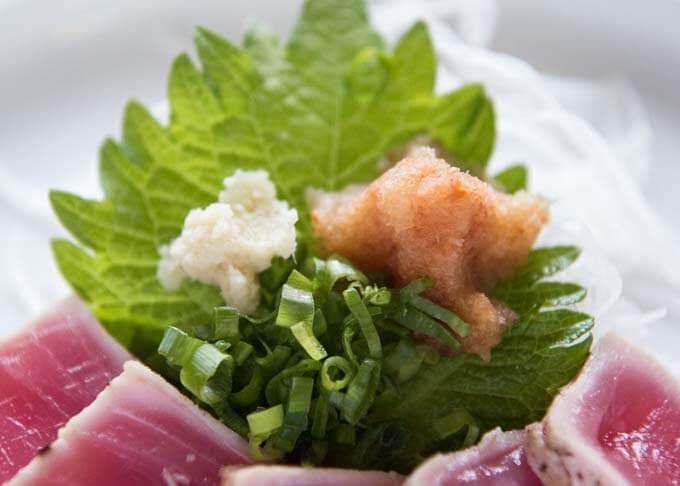
Bonito Tataki is usually served with grated ginger and chopped shallots, and sometimes with garlic. On the other hand, ponzu is often used with a spicy condiment called momiji oroshi, which is made by grating daikon and chillies together (see the next section).
So, I decided to serve all of them with Tuna Tataki. These condiments go very well with Ponzu. I plated it in a certain way, but it is up to you how you want to place the condiments and tuna slices.
You might have noticed this but I used a different block of tuna from the tuna in Option 1. The tuna slices are not square this time. It looks almost like the world-famous chef Nobu’s Tuna Tataki!
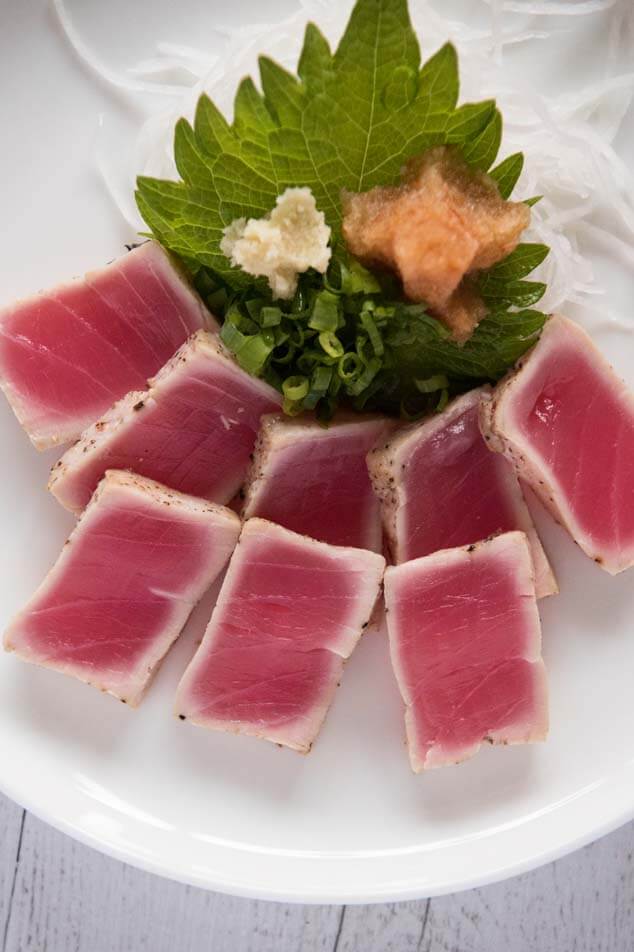
About Momiji Oroshi (もみじおろし)
Momiji oroshi is a spicy condiment that goes very well with Ponzu. It is also used widely in Japan as a condiment for hot pot dishes where the broth of the hot pot is plain.
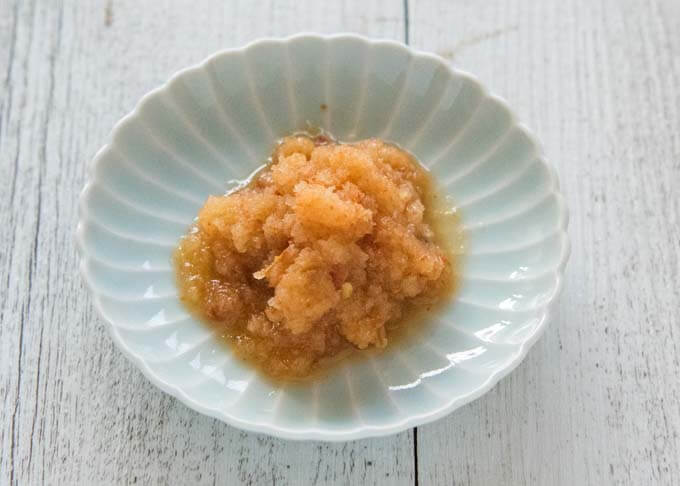
The word ‘momiji’ (もみじ)means Japanese maple tree and ‘oroshi’ comes from the word ‘daikon oroshi‘, which means grated daikon. The colour of red chillies resembles autumn Japanese maple tree leaves so people call it momiji oroshi.
The traditional method of momiji oroshi is to grate daikon embedded with red chillies. Poke few holes in a piece of daikon and fill the holes with red chillies. Then grate the daikon with the chilies inside.
But I found that it is quite difficult to push chillies into small deep holes and sometimes the chillies are pulled out of the holes.
The alternative method I use these days is easier. Make a vertical incision to the daikon piece, three quarters of the way through, so that the bottom part of the daikon is intact. Place the chillies inside the incision vertically, then hold the daikon firmly so that the chillies do not fall out. Then grate the daikon.
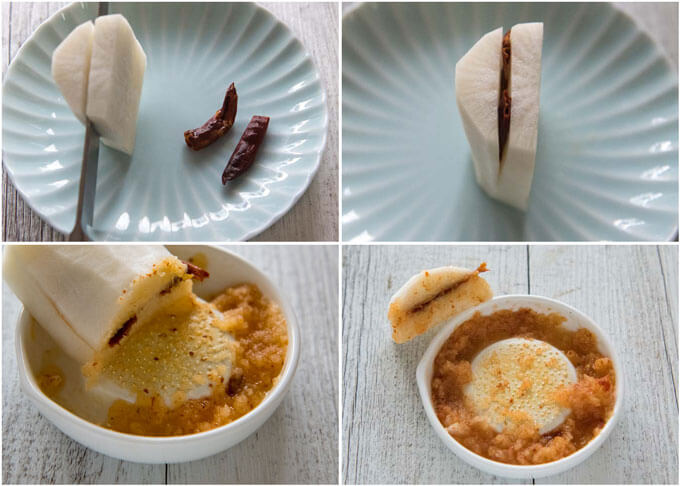
Searing tuna is a very easy way of preparing sashimi and making a stunning presentation of the dish. The red of raw sashimi and light brown trimmings of seared edges look so attractive. Dress it up with vegetables with a great colour combination and impress your diners!
Yumiko![]()
P.S. Don’t forget to see the section ‘MEAL IDEAS’ below the recipe card! It gives you a list of dishes that I have already posted and the new recipe in this post that can make up a complete meal. I hope it is of help to you.
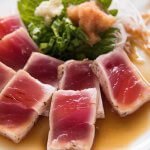
My Tuna Tataki is a block of sashimi tuna lightly seared and served with Ponzu Dressing. It is almost like the Tuna Tataki dish at the world-famous chef Nobu’s restaurant.
Prep Time does not include the time required to make Ponzu.
- 100g/3.5oz x 2 sashimi tuna blocks (note 1)
- Black pepper and salt (note 2)
- 1 tbsp oil
- 4 tbsp Ponzu (note 3)
- 2 perilla leaves
- 20g/0.7oz daikon , julienned finely (note 4)
- 1 small yellow tomato , halved
- 2 perilla leaves
- 20 g/0.7oz daikon , julienned finely (note 4)
- 1 tbsp shallots , finely chopped
- 1 tsp grated ginger
- 2 tbsp Momiji Oroshi
- 50g/1.8oz daikon
- 2 dried whole chillies , deseeded and rehydrated
-
Soak the julienned daikon in ice water to crisp.
-
Place the tuna blocks on a cutting board. Salt lightly and sprinkle black pepper over the long sides of the blocks (note 6). Do not put salt and pepper on the two small sides that are perpendicular to the long sides.
-
Heat a frying pan with oil over high heat.
-
When the frying pan becomes hot, place the tuna blocks on one long side at the bottom.
-
Cook until the bottom of the tuna changes colour, about 2-3mm/ 1/8" into the flesh (about 15-20 seconds, note 7).
-
Turn the block 90 degrees and repeat cooking each long side in the same way.
-
Remove the tuna blocks to a plate, leave them to cool (note 8). You can put them in the fridge to speed up the cooling process.
-
Slice the seared tuna into 5-6mm/¼" thick pieces.
-
Place a perilla leaf in the centre of each serving plate.
-
Place half of the tuna tataki slices around each perilla leaf.
-
Drain and squeeze the daikon to get rid of excess moisture and pile up half of the daikon on the perilla leaf on each plate, topped with a piece of tomato.
-
Drizzle 2 tablespoons of Ponzu over the tuna pieces on each plate. Serve immediately.
-
Drain and squeeze the daikon to get rid of excess moisture and pile up half of the daikon on each serving plate, slightly off-centred.
-
Place a perilla leaf on the side of each daikon mound so that the leaf lays diagonally.
-
Spread the tuna slices next to the perilla leaf only slightly overlapping each other (or no overlapping if the plate is large).
-
Place shallots, ginger and Momiji Oroshi on each perilla leaf.
-
Drizzle 2 tablespoons of Ponzu over the tuna pieces on each plate. Serve immediately.
-
Make a vertical incision to the daikon piece, three quarters of the way through so that the bottom part of the daikon is intact.
-
Squeeze the chillies to remove excess moisture and place them in the slit of the daikon vertically.
-
Hold the daikon firmly, facing the opening down, so that the chillies do not fall out.
-
Grate the daikon with chillies using a fine grater.
1. I used two cuboid shaped tuna blocks that are about 3cm x 3cm x 10cm/1¼" x 1¼" x 4" each (Serving Option 1 photo). I also used 3cm x 4cm x 7.5cm/1¼" x 1½" x 3" (Serving Option 2 photo). It does not have to be the same size and the thickness can vary, i.e. when sliced, it does not have to be square.
I recommend that the length be no longer than 15cm/6” as it becomes difficult to handle. The thickness needs to be no less than 3cm otherwise you can’t see much of the red raw meat within the seared trimming.
2. The amount of pepper depends on how spicy you want it to be but do not make it too peppery. See the step-by-step photo as a guide.
3. Please see the Ponzu recipe in my post Japanese Dressings. You can keep Ponzu for many months in the fridge, so I recommend making a good quantity ahead of time. Ponzu is great for Chilled Tofu, Yudōfu and hot pot dishes such as Shabu-shabu.
4. I used a 10cm/4" long piece of daikon to make long strands of daikon salad. Slice the daikon lengthwise very thinly, then pile sheets of daikon slices up in the same direction and slice them very thinly.
5. Momiji oroshi is a spicy grated daikon with chillies. It is called this because the red colour of the daikon resembles the autumn momiji (Japanese maple tree) leaves.
The recipe for Momiji Oroshi makes more than you need for Tuna Tataki. But you can keep Momiji Oroshi in the freezer. It goes very well with Ponzu Dressing.
6. I place two tuna blocks close together on a cutting board and sprinkle salt and pepper. Then turn the block 90 degrees and sprinkle pepper and salt. Repeat to season four long sides of the tuna block.
7. Depending on the temperature of your frying pan, the duration varies. Instead of relying on cooking duration, check the thickness of the seared portion – 2-3mm/ 1/8".
8. Do not slice the seared tuna while warm as it tends to break and become flaky.
9. Nutrition per serving as a main.
serving: 191g calories: 203kcal fat: 7.7g (12%) saturated fat: 0.7g (3%) trans fat: 0.1g polyunsaturated fat: 1.4g monounsaturated fat: 5.2g cholesterol: 39mg (13%) sodium: 655mg (27%) potassium: 627mg (18%) carbohydrates: 6.8g (2%) dietary fibre: 0.9g (3%) sugar: 4.7g protein: 26g vitamin a: 9.1% vitamin c: 20% calcium: 1.4% iron: 6.2%
Meal Ideas
A typical Japanese meal consists of a main dish, a couple of side dishes, a soup and rice. I try to come up with a combination of dishes with a variety of flavours, colours, textures and make-ahead dishes.
I decided to serve Tuna Tataki as a side dish in this Meal Idea. You can adjust the quantity of Tuna Tataki to suit to your appetite. Since Ponzu is a sour dressing, I serve Japanese Meat and Potato Stew (Nikujaga) which has a slightly sweet flavour with a small quantity of meat.
- Main: Japanese Meat and Potato Stew (Nikujaga) – make ahead
- Side dish 1: Tuna Tataki (Seared Tuna) with Ponzu Dressing – today’s recipe, make-ahead Ponzu Dressing
- Side dish 2: Japanese Fried Eggplant (Agedashi Nasu) – you can make ahead and served hot, cold, or at room temperature
- Soup: Miso Soup of your choice from Miso Soup Ingredient Combinations or your favourite ingredients
- Rice: Cooked Rice
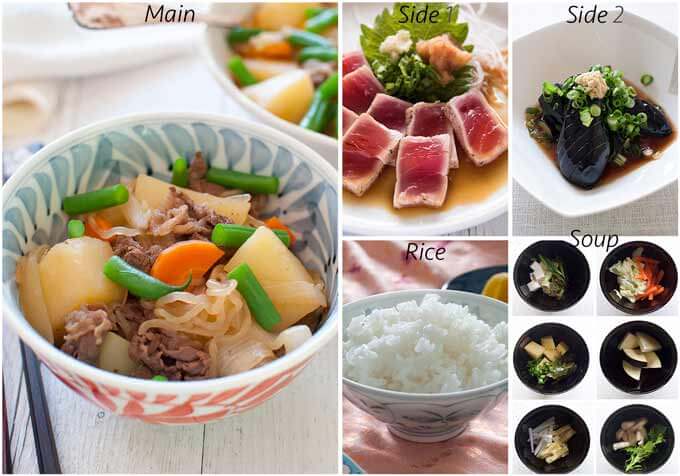
Looks so good! Any tips on where to buy sashimi Tuna in a block like that in Sydney?
Hi Nicola, I have not seen the exact shape like the block that I seared. But you can buy a thick sashimi block from Sydney Fish Market and cut it half lengthwise to make a block like those in my photo. Also at Japanese grocery shop – Tokyo Mart in Northbridge and Lucky Mart in Artarmon, they sell frozen tuna sashimi block which can be halved lengthwise to make the black exactly like that.
This was so good. What’s not to like about tuna & ponzu? Yumiko I never had ponzu until the other day thanks to you. 🙂 thankfully they sell it in local grocery stores as well here. I do notice a few different types. Some with lime and others just citrus. What’s your preference ?
Best Regards
Steven in Florida.
Hi Steven, It’s convenient to have a Japanese shop to go to in case you want to take a short cut or try something new. My favourite ponzu is yuzu flavoured ponzu. They sometimes call it ‘yuzupon’. Yuzu is a Japanese citrus which has a distinctive and stronger fragrances than lime, Lemmon or orange, I think.
Yuzu tastes exactly like calamondin, a citrus variety found in Florida that resembles the kumquat
Hi Doug, I have not seen calamondin where I live. I must hunt for it!
Yumiko thank you for such detailed instructions, it looks so delicious and is indeed a restaurant worthy presentation.
Hi Elizabeth, thanks a lot! After making few and taking photos etc, I still thought it looked good and they were really yummy.
Yuuum! Mum, this looks sooo good! When are you making this for family dinner??
Thank you, Nagi! It’s been 6 weeks since I got back from Japan. Perhaps, we should have a family Japanese dinner soon.